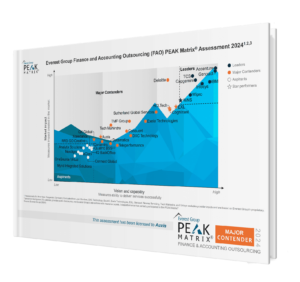In brief:
- Applying speed and efficiency to the payment process is a competitive advantage in a world impacted by talent, supply shortages, and uncertain economic conditions.
- Despite technology’s promise to optimize business processes, 50% of ERP implementations fail to deliver the expected benefits.
- There are five SAP best practices that are essential to unlocking the biggest benefit from your ERP implementation.
SAP’s market-leading enterprise resource planning (ERP) solutions can be game changers for accounts payable departments. But ERP implementation only delivers results with the right strategy – and following SAP best practices is key to elevating cash flow, operational efficiency, supplier relationships, and the strategic value of the accounts payable (AP) function.
ERP systems serve as company command centers, using integrated modules to manage business processes across departments and centralize data to create a single source of truth.
SAP calls the finance module the “backbone” of its ERP system, and AP is a key component. Nearly 40,000 companies currently benefit from its ability to create a clear financial picture through real-time insights, intelligent automation, a centralized record system, streamlined business processes, and a 360-degree view of enterprise performance.
The global ERP software market is projected to jump from $46.86 billion in 2023 to $71.34 billion by 2030 as macroeconomic conditions make streamlining business processes and enhancing operational efficiency a priority. More than half of enterprises rank ERP implementation as an investment priority, according to data collected by G2.
SAP is a top player in the ERP software market: 85 of the 100 largest companies in the world use SAP’s cloud-based S/4HANA ERP system alone, states SAP’s 2023 corporate fact sheet.
But despite the promise of ERP technology, it’s no secret that an alarming 50% of implementations fail across all ERP software. Most organizations are unable to maximize the capabilities of their new ERP system as well; for example, a whopping 99% of businesses say they struggle to access their data.
Here we share five SAP best practices that are essential to unlocking the biggest benefit from your ERP implementation.
1. Maximize automation.
Automating back office business processes like accounts payable (AP) to drive efficiency and lower costs is the C-suite’s top digital investment priority, according to a Gartner survey of CFOs and CEOs. More than 40% of finance leaders expect their AP departments to be fully automated by 2025, states an Institute of Financial Operations and Leadership (IFOL) report.
SAP ERP implementation offers a wealth of automation opportunities that infuse AP with cost-effective accuracy and efficiency, while also catching fraud more easily and strengthening vendor relationships with prompt payments:
Preconfigured, best-practice workflows can ensure timely payment processing.
Automate time-consuming processes like invoice approvals, payment authorizations, and exception handling in your new ERP system applications. Automated reminders and escalation paths keep the process moving forward when there isn’t a timely response – avoiding late payments, extra charges, and outstanding debts. SAP automation tools can also speed payment processing; for example, enabling AP to directly connect to banks, track a transaction’s entire payment lifecycle, and improve straight-through processing rates and internal compliance.
Advanced automation capabilities like OCR help eliminate AP’s biggest pain points.
Optical Character Recognition (OCR) automatically captures data from paper invoices and converts it into a standard digital format that flows seamlessly into your SAP ERP system’s fields.
Automated vendor portals strengthen goodwill.
Improve vendor visibility into the payment process by storing all the information related to an account in a single place, with real-time status updates and messaging capabilities. AP teams that deal with many large vendors can integrate their EDI (electronic data interchange) with your SAP ERP system as well to facilitate instant, secure transfer of payments, messages, and documents.
The AI-powered Business Automation platform from market-leading UiPath is also an SAP-endorsed application, significantly extending and customizing your ERP system’s automation opportunities with the right implementation partner.

2. Mitigate fraud and payment errors by strengthening master data management.
Managing the master vendor data file is a common AP challenge: 67% of respondents in a CFO & Controller poll admitted their file “could use a little cleaning.” Nearly 20% called it “a total mess.”
Data decay is unavoidable, with vendor information like banking details or primary contact information often changing over time. Files with many inactive suppliers increase the risk of errors and fraud.
Critical contact data like email addresses are missing for 95% of vendors in a typical master data file as well, according to a Forbes report. Unfortunately, that opens the door to email scams, which have targeted nearly 60% of AP organizations – more than any other business department, according to the Association for Financial Professionals 2022 Payments Fraud and Control Report.
Segregating duties across staff is a vital AP control, decreasing opportunities for committing and hiding fraud while performing work. But successful ERP implementation also brings applications with robust capabilities for strengthening master data controls, creating a central hub for master data management and governance:
Implement proper controls.
Mitigate the risk of fraudulent requests by creating stringent rules around vendor creation, modification, and approval processes. A complete audit trail of changes further decreases risk and simplifies compliance.
Regularly review and cleanse vendor records.
Keep vendor master data accurate and up to date in your SAP ERP implementation. Master data consolidation runs can merge duplicate vendors. Predefined rules and controls can also remove/block suppliers from vendor master data files that have been inactive for one year.
Prevent inaccurate information from compromising your master data file.
Take advantage of preconfigured review/approval workflows to ensure only high-quality source data is uploaded.
3. Create a seamless flow between your procurement and payment systems.
With responsibility for obtaining goods and services, Procurement links strategically to AP workflows. But traditionally, the departments operate in silos.
SAP ERP implementation can integrate your AP and Procurement systems, facilitating an efficient purchase-to-pay process that reduces risk, increases working capital, strengthens supplier relationships, and controls costs.
Maximize features that benefit both departments.
Assess Procurement activities as part of your ERP implementation process. For instance, inventory integrations can optimize inventory levels, reduce stockouts, and improve order accuracy.
Replace third-party procurement tools with SAP features.
For example, creating purchase requisitions and purchase orders (POs) in your SAP ERP system ensures seamless integration with AP workflows and data fields.
4. Transform the tedious three-way matching process with your SAP ERP implementation.
Three-way matching stands as a vital AP control, ensuring vendor invoices are only paid after they are validated against corresponding purchase orders and goods receipts. Besides avoiding duplicates or overpayments, three-way matching is critical to catching invoice fraud.
What AP leader didn’t lose sleep over this nightmare scenario: the Lithuanian cybercriminal recently convicted of using invoice fraud to trick Google and Meta, formerly Facebook, into making $23 million and $100 million payments, respectively.
But while three-way matching is a simple business process at its core, performing it manually is labor-intensive – especially when discrepancies occur or invoice volumes are high. Not only does it distract AP staff from more valuable activities, but chasing down information can create payment delays that rack up late charges and ill will with suppliers.
Manual three-way matching also creates room for human error, like misplaced paperwork, misread figures, and misunderstood agreement terms.
So, how can you use your SAP ERP implementation to avoid these issues?
Leverage three-way matching functionality in your SAP ERP system.
Automatically ensure key details like unit pricing, quantity, and totals are accurate.
Create rules and procedures for handling discrepancies and detecting duplicate invoices.
SAP workflows can automatically route exceptions identified during the matching process to the correct business stakeholder for resolution. That saves AP teams valuable time figuring out the next steps.
Decrease bottlenecks by setting tolerance thresholds.
Reduce the number of exceptions requiring further investigation. For instance, you can tell your ERP system to approve matches with discrepancies of $100 or less.
Regularly reconcile and clear open items.
Use your SAP ERP implementation to ensure accurate AP balances for your month-end close.
5. Work smarter with real-time reporting and analytics.
Finance executives are laser-focused on improving cash flow in 2023, as recession fears and inflationary impacts increase pressure to optimize AP payment strategies, according to Everest Group’s Global CFO survey.
Properly leveraging real-time reporting and analytics capabilities in your SAP system helps finance leaders keep a critical eye on cash. Gain valuable insight into AP’s core processes – helping teams better understand their data, increase operational efficiency, avoid late payments, improve internal controls, and ensure timely funding and approvals.
Analytics based on AP data deliver important benefits to other business departments as well. For example, helping accounting departments anticipate cash flow challenges or identifying price increases so Procurement can prioritize longer-term contracts.
Determine top priorities.
Set up reports and dashboards focused on AP performance, cash flow management, vendor spending, payment trends, and payment priorities. Your SAP ERP offers a library of standard reports that can be tailored to display information in a specific format and automatically distributed to specific audiences. Reports can also be customized to meet unique requirements.
Keep tight control with real-time monitoring of key AP metrics and KPIs.
Identify process bottlenecks, improve efficiency, and optimize working capital. You can easily track aging invoices, check invoice volumes, calculate Days Payable Outstanding (DPO) and Payment On-Time metrics, and more.
Integrate SAP’s built-in reporting capabilities with business intelligence tools.
For instance, integrating SAP with Microsoft PowerBI takes reporting to the next level, offering rich analytics and visualizations like real-time productivity reports that drive smarter decision-making.
Why Auxis: Maximize AP performance with the right SAP implementation partner
SAP boasts a wealth of accolades to underscore its position as an ERP market leader, including 2022 Leader rankings on the Gartner Magic Quadrant reports for cloud ERP service-centric and product-centric enterprises.
But maximizing the capabilities of your ERP implementation is no simple task – and without a seasoned team, most enterprises struggle to achieve expected benefits.
Auxis, a reputable AP outsourcing partner, delivers the SAP best practices, knowledge, talent, and support to optimize AP operations for peak performance. We have deep experience with SAP tools and features to ensure you achieve the desired outcomes. We also stay up to date with new SAP best practices and features so you can utilize the latest enhancements.
Auxis teams are more than transactional delivery providers. We are trained to identify challenges in your AP lifecycle – realizing the greatest SAP ERP benefits with business process improvements that weed out complexity, reduce costs, and mitigate risk. As a UiPath Partner, we can also solve AP challenges with customized automation solutions that take your SAP ERP implementation to the next level.
In a world of scarce talent, uncertain economic conditions, and supply shortages, infusing the payment process with speed and efficiency is a competitive necessity. The right AP outsourcing partner is key to taking full advantage of the world-class functionality your ERP implementation offers while keeping your system scalable and agile for future growth.
Want to learn more about achieving peak AP performance and successful ERP stabilization and enhancement? Schedule a consultation with our AP outsourcing experts today! You can also read our blog for more Finance & Accounting Outsourcing tips and strategies. Or, read our case studies for success stories!







